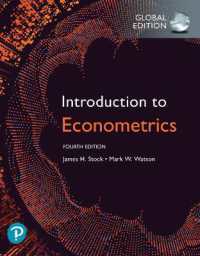- ホーム
- > 洋書
- > 英文書
- > Science / Mathematics
Full Description
This book is intended to be an introduction to the fascinating theory ofgeneralized polygons for both the graduate student and the specialized researcher in the field. It gathers together a lot of basic properties (some of which are usually referred to in research papers as belonging to folklore) and very recent and sometimes deep results. I have chosen a fairly strict geometrical approach, which requires some knowledge of basic projective geometry. Yet, it enables one to prove some typically group-theoretical results such as the determination of the automorphism groups of certain Moufang polygons. As such, some basic group-theoretical knowledge is required of the reader. The notion of a generalized polygon is a relatively recent one. But it is one of the most important concepts in incidence geometry. Generalized polygons are the building bricks of Tits buildings. They are the prototypes and precursors of more general geometries such as partial geometries, partial quadrangles, semi-partial ge ometries, near polygons, Moore geometries, etc. The main examples of generalized polygons are the natural geometries associated with groups of Lie type of relative rank 2. This is where group theory comes in and we come to the historical raison d'etre of generalized polygons. In 1959 Jacques Tits discovered the simple groups of type 3D by classifying the 4 trialities with at least one absolute point of a D -geometry. The method was 4 predominantly geometric, and so not surprisingly the corresponding geometries (the twisted triality hexagons) came into play. Generalized hexagons were born.
Contents
1 Basic Concepts and Results.- 1.1 Introduction.- 1.2 Geometries.- 1.3 Generalized polygons.- 1.4 Generalized quadrangles.- 1.5 Projections and projectivities.- 1.6 Structure of weak generalized polygons.- 1.7 Finite and semi-finite generalized polygons.- 1.8 Subpolygons.- 1.9 Regularity.- 2 Classical Polygons.- 2.1 Introduction.- 2.2 Classical and alternative projective planes.- 2.3 Classical generalized quadrangles.- 2.4 Classical generalized hexagons.- 2.5 Classical generalized octagons.- 2.6 Table of notation for some classical polygons.- 3 Coordinatization and Further Examples.- 3.1 Introduction.- 3.2 General coordinatization theory.- 3.3 Generalized quadrangles and hexagons.- 3.4 The classical and mixed quadrangles.- 3.5 The classical hexagons.- 3.6 The Ree—Tits octagons.- 3.7 Some non-classical quadrangles.- 3.8 Other generalized polygons.- 4 Homomorphisms and Automorphism Groups.- 4.1 Introduction.- 4.2 A theorem of Pasini on epimorphisms.- 4.3 Notation and results from group theory.- 4.4 Root elations and generalized homologies.- 4.5 Collineations of classical polygons.- 4.6 Collineation groups of finite classical polygons.- 4.7 The Tits condition.- 4.8 Finite point-distance transitive and flag-transitive polygons.- 4.9 Kantor systems.- 5 The Moufang Condition.- 5.1 Introduction.- 5.2 First properties of Moufang polygons.- 5.3 Weiss' theorem.- 5.4 Root systems.- 5.5 Commutation relations and classification.- 5.6 Another result of Weiss.- 5.7 Finite Moufang polygons.- 5.8 Simplicity of the little projective group.- 5.9 Point-minimal and line-minimal Moufang polygons.- 6 Characterizations.- 6.1 Introduction.- 6.2 Regularity in generalized quadrangles.- 6.3 Regularity in generalized hexagons.- 6.4 Regularity in generalized polygons.- 6.5 Hyperbolic andimaginary lines.- 6.6 Generalized Desargues configurations.- 6.7 Some combinatorial characterizations.- 6.8 Some algebraic characterizations.- 6.9 The perfect Ree—Tits octagons.- 7 Ovoids, Spreads and Self-Dual Polygons.- 7.1 Introduction.- 7.2 Generalities about polarities and ovoids.- 7.3 Polarities, ovoids and spreads in Moufang polygons.- 7.4 Moufang quadrangles of type (BC — CB)2.- 7.5 Polarities, conics, hyperovals and unitals in Pappian planes.- 7.6 Suzuki quadrangles and Suzuki-Tits ovoids.- 7.7 Ree hexagons and Ree-Tits ovoids.- 7.8 Amalgamations.- 8 Projectivities and Projective Embeddings.- 8.1 Introduction.- 8.2 Some more properties of the Ree-Tits octagons.- 8.3 The little projective groups of some Moufang polygons.- 8.4 Groups of projectivities of some Moufang polygons.- 8.5 Projective embeddings of generalized quadrangles.- 8.6 Ideal, weak and lax embeddings of polygons.- 8.7 Embeddings of the slim Moufang polygons.- 9 Topological Polygons.- 9.1 Introduction.- 9.2 Definition of topological polygons.- 9.3 Examples.- 9.4 General properties.- 9.5 The impact of algebraic topology.- 9.6 Transitivity properties.- 9.7 Polygons with valuation.- 9.8 Other categories.- Appendices.- A An Eigenvalue Technique.- B The Theorem of Bruck and Kleinfeld.- C Tits Diagrams for Moufang Quadrangles.- D Root Elations of Classical Polygons.- E The Ten Most Famous Open Problems.








